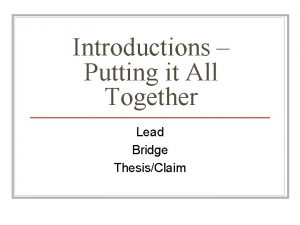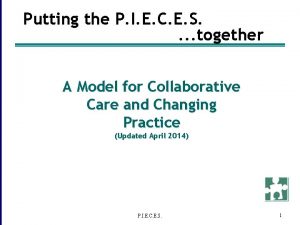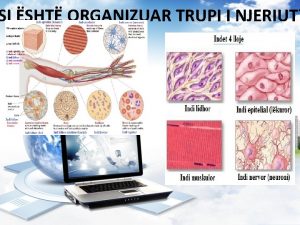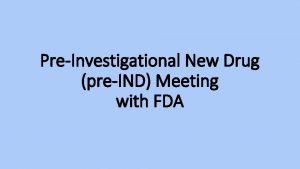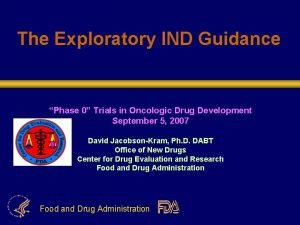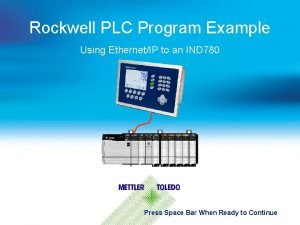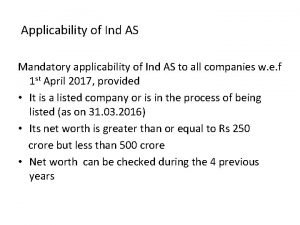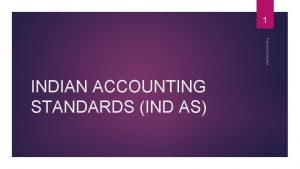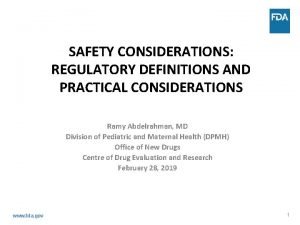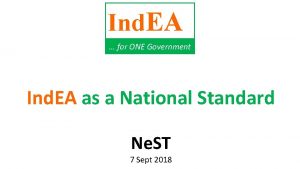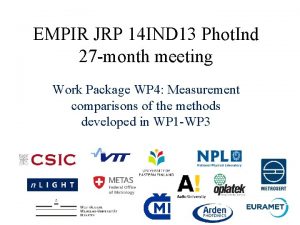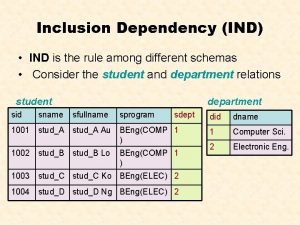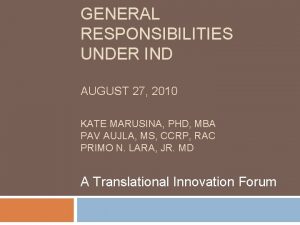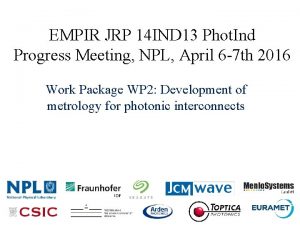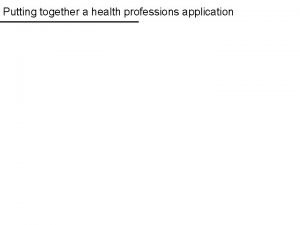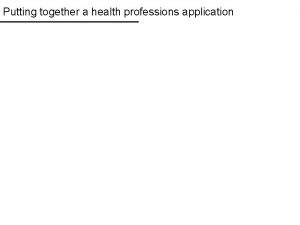Putting Together Your IND Application OTAT Preclinical Considerations










![Preclinical Expectations for Early Phase Clinical Trials • Proof-of-concept [POC] – in vitro / Preclinical Expectations for Early Phase Clinical Trials • Proof-of-concept [POC] – in vitro /](https://slidetodoc.com/presentation_image/18f5cb58302b4d009f002870f7b39d74/image-11.jpg)






















- Slides: 33

Putting Together Your IND Application (OTAT): Preclinical Considerations for Cell and Gene Therapies Allen Wensky, Ph. D. FDA/CBER/OTAT/DCEPT/PTB II allen. wensky@fda. hhs. gov Clinical Investigator Training Course November 9, 2016

Overview • Regulatory Review Principles • CBER/OTAT-Regulated Products: Safety Concerns • Preclinical Evaluation – Study Design Considerations • IND Content • Potential Pitfalls / Regulatory Issues • Working with FDA/CBER/OTAT 2

21 CFR 312. 20 Subpart B: IND Application Form FDA 1571 21 CFR 312. 23(a)(1) Table of Contents Introductory statement and general investigational plan 21 CFR 312. 23(a)(2) 21 CFR 312. 23(a)(3) Investigator’s brochure 21 CFR 312. 23(a)(5) Protocols 21 CFR 312. 23(a)(6) Chemistry, manufacturing, and control data 21 CFR 312. 23(a)(7) Pharmacology and toxicology data 21 CFR 312. 23(a)(8) Previous human experience 21 CFR 312. 23(a)(9) Additional information 21 CFR 312. 23(a)(10) 3

What Regulations Govern Preclinical Testing? Pharmacologic & Toxicologic Studies “…adequate information about the pharmacological and toxicological studies…on the basis of which the sponsor has concluded that it is reasonably safe to conduct the proposed clinical investigations. The kind, duration, and scope of animal and other tests required varies with the duration and nature of the proposed clinical investigations. ” IND Regulations [21 CFR 312. 23 (a)(8) - Pharmacology and Toxicology] 4

• Final Guidance § § § Current Thinking of the Agency on this Topic First Comprehensive FDA Guidance on Preclinical Assessment of Cell and Gene Therapy (CGT) Products Explicitly Incorporates 3 R’s: Recommendations to reduce, refine, and replace animal use in a preclinical program 5

CBER Review: Product-Based • No “one size fits all” regulatory approach • Data necessary to support development depends on the characteristics of the product • Preclinical studies are designed to support use of a specific product for a specific clinical indication. • Review approach is based on balancing risk and benefit. 6

Potential Safety Concerns for Therapeutic Vaccines/Adjuvants • Systemic toxicity – Immune-mediated toxicity - autoimmune response, induction of pro-inflammatory response/cytokine release, organ toxicity – Hypersensitivity / anaphylaxis – Potential “off-target” toxicity – Adjuvant related toxicity • Local toxicity – Injection site reaction 7

Potential Safety Concerns for Cell-Based Products • Risks of the delivery procedure • Ex vivo manipulation (e. g. , expansion, genetic modification, encapsulation, scaffold seeding) • Potential inflammatory / immune response to the administered cellular product • Inappropriate cell proliferation (i. e. , tumor formation) • Inappropriate cell differentiation (i. e. , ectopic tissue formation) • Cell migration to non-target areas / tissues • Interactions with concomitant therapies 8

Potential Safety Concerns for Gene Therapy Products • • Risks of the delivery procedure Type of vector / virus Vector / virus biodistribution to non-target tissues Level of viral replication and persistence in nontarget tissues Inappropriate immune activation Potential for insertional mutagenesis and/or oncogenicity Transgene related concerns Genetically modified cells – see cell therapy concerns 9

Expectations from Preclinical Data • To support a rationale for the first-in-human clinical trial – For cell and gene therapy product, the trial is usually conducted in the disease population, not in healthy volunteers • To make recommendations regarding clinical trial design – Initial safe starting dose, dose-escalation scheme, dosing schedule, organ toxicity, eligibility criteria, clinical monitoring • To meet regulatory requirements – 21 CFR 312. 23 (a)(8) – 21 CFR 58 (GLP compliance) 10
![Preclinical Expectations for Early Phase Clinical Trials Proofofconcept POC in vitro Preclinical Expectations for Early Phase Clinical Trials • Proof-of-concept [POC] – in vitro /](https://slidetodoc.com/presentation_image/18f5cb58302b4d009f002870f7b39d74/image-11.jpg)
Preclinical Expectations for Early Phase Clinical Trials • Proof-of-concept [POC] – in vitro / in vivo – Potential mechanism of action [e. g. , neuroprotective, neoangiogenesis, tolerance induction] – Establish pharmacologically effective dose(s) – Optimize route of administration (ROA) / dosing regimen – Rationale for species / model selection for further testing • Safety of conducting clinical trial – benefit / risk – – Dosing scheme Potential target tissue(s) of toxicity / activity Parameters to monitor clinically Eligible patient population 11

Preclinical Study Design(s) • Assess pharmacology / POC / vector distribution / cell fate in relevant animal model(s) of disease / injury, as feasible • Assess safety / toxicology (T) / vector distribution / cell fate in healthy animals • Hybrid pharmacology-toxicology study design – POC + T + product fate – incorporate activity and safety endpoints in an animal model of disease / injury – Local microenvironment and pathophysiology status of the model may impact the safety / bioactivity of the product 12

Preclinical Study Design(s) • Apply the 3 R’s – Reduce, Refine, Replace – in preclinical study designs – We encourage you to explore opportunities for reducing, refining, and replacing animal use in your preclinical program. – Consider in vitro or in silico testing to complement or replace animal studies – We encourage the submission of proposals with justification for any potential alternative approaches 13

Comparability of the Product Administered to the Intended Clinical Product • Manufacturing process of the product used in the preclinical studies should be as similar to the intended clinical product as possible – Tissue / sample harvest, cell isolation, expansion, culturing, formulation / scaffold seeding, encapsulation procedure, storage conditions, etc. – Vector production / final formulation • Adequate product characterization – Cellular morphology and phenotype – Molecular / biochemical markers – Vector sequence, genomes, empty capsid 14

Preclinical Study Design: Specifics • Nonbiased design – Randomized assignment to groups – Appropriate controls (e. g. , sham, vehicle) – In-life and postmortem assessments conducted in a blinded manner • Mimic clinical scenario as closely as possible – Use cells intended for clinical use…or analogous cells – Cell viability, concentration / formulation, volume, rate of delivery, implant site, number of implants / injections, etc – ROA, delivery system, timing of cell delivery, dosing regimen, etc – Anatomical location / extent of the diseased / injured area 15

Preclinical Study Design: Specifics (cont’d) • Adequate numbers of animals / group to ensure biologically robust interpretation • Sufficient study duration and multiple time points depending on the biology of the product - to allow for adequate assessment of: – Functional, laboratory, and morphological outcomes – Cell fate – Onset and persistence profile of significant findings in target / non-target tissues 16

Preclinical Study Design: Specifics (cont’d) • Standard Toxicology Endpoints – Mortality – Clinical observations, body weights, appetite, etc – Clinical pathology - hematology, coagulation, serum chemistry, urinalysis – Pathology – target and non-target - Scheduled and unscheduled deaths - Comprehensive gross pathology - Microscopic pathology – blinded assessment • Terminal / non-terminal assessment – Various imaging modalities – Immunohistochemistry, in situ hybridization, PCR 17

Preclinical Study Design: Specifics (cont’d) • Product-dependent endpoints – Depends on the vector / transgene • Potential for insertional mutagenesis • Potential for carcinogenicity / tumorigenicity • Host immune response to vector and /or transgene – Depends on the transduced / nontransduced cell type • Host immune response to transduced cell • Potential for unregulated growth / tumorigenicity – Depends on the disease / injury of focus (cardiac, neurological, status / function of hematopoietic cells, etc) 18

GT Biodistribution (BD) Profile • Determine potential for vector BD in germline, target, and non-target tissues – Distribution profile – Persistence and clearance profile • Determine the transgene expression profile in ‘vector positive’ tissues – Distribution profile – Persistence and clearance profile • For details regarding sample collection and the PCR assay refer to: – Guidance for Industry: Gene Therapy Clinical Trials - Observing Subjects for Delayed Adverse Events (11/06) • Biodistribution data may impact study design (e. g. , duration, dosing regimen, etc) 19

Considerations for Appropriate Animal Species/Model • Comparative physiology of animal to human § Model of disease / injury § Local microenvironment may impact the safety of the product • Route of administration – comparability to clinical § Systemic vs. targeted delivery § Delivery system / delivery procedure • Species specificity of the product • Species specificity of the innate immune response 20

Appropriate Animal Species/Model • There is no ‘default’ to the use of nonhuman primates • There is no ‘default’ to the use of both a rodent and a non-rodent species • There is no ‘default’ to the use of multiple species • Understand the limitations of the species/ model(s) used • Scientific justification should be provided for the animal species / model(s) used 21

Regulatory Expectations for Toxicology Studies 21 CFR 312. 23 (a)(8) – Pharmacology and Toxicology • For each toxicology study intended primarily to support safety, a full tabulation of data should be submitted • Each toxicology study submitted should be performed per GLP, or an explanation provided 22

Submit Complete Reports for Toxicology Studies • Detailed description of the study performed: – – – Test articles (i. e. , relevance to the clinical product) Test system (i. e. , animal species / model) Delivery device information if applicable Dose levels / dose regimen / study duration Study groups (controls, test article groups, group size, etc) Prospective study endpoints • Results: for all parameters evaluated– Submit individual animal data for all parameters evaluated – Submit summarized and tabulated results • Interpretation of the data 23

Sources of Data to Support an IND • GLP-compliant toxicology studies conducted by a certified testing facility • Well-controlled studies conducted in house • Published data in peer-reviewed journals • Cross-reference to similar products in previously submitted Master Files (MFs) / IND’s • Detailed clinical study reports from clinical trials 24

Potential Pitfalls When Submitting an IND • Insufficient information to assess patient risk – Lack of preclinical safety data – Incomplete safety study reports – Insufficient product characterization • Inadequate preclinical study design – – Safety monitoring (safety / activity endpoints) Animal number Study dose and duration Route of administration 25

Regulatory Issues for Clinical Trials • Common reasons for not allowing a clinical trial to proceed (clinical hold) are: • Clinical start dose: Insufficient safety data to support the intended human start dose • Dose escalation scheme: Too aggressive • Safety monitoring: Inadequate monitoring plan to observe potential toxicities • Patient population: Eligibility criteria inappropriate • The potential benefits do not outweigh potential risks 26

Early Communication with OTAT • Pre-pre. IND interactions – Non-binding, informal scientific discussions between CBER/OTAT nonclinical review disciplines (P/T & CMC) and the sponsor – Initial targeted discussion of specific issues – Primary contact: Mercedes Serabian mercedes. serabian@fda. hhs. gov • Pre. IND meetings – Non-binding, but formal meeting between FDA and sponsor (with minutes generated) – Meeting package should include summary data and sound scientific principles to support use of a specific product in a specific patient population 27 27

Summary It is important to keep FDA/CBER/OTAT involved at an early phase of the product development program, to enable identification of potential issues and the appropriate pathway to resolution • The preclinical study designs should be supported by scientific rationale / data • Novel therapies mean novel testing paradigms • 28

Selected Guidances • Guidance for Industry: Preclinical Assessment of Investigational Cellular and Gene Therapy Products (November 2013) http: //www. fda. gov/downloads/Biologics. Blood. Vaccines/Guidance. Compliance Regulatory. Information/Guidances/Cellularand. Gene. Therapy/UCM 329861. pdf • Draft Guidance for Industry: Considerations for the Design of Early-Phase Clinical Trials of Cellular and Gene Therapy Products (July 2013) http: //www. fda. gov/downloads/Biologics. Blood. Vaccines/Guidance. Compliance Regulatory. Information/Guidances/Cellularand. Gene. Therapy/UCM 359073. pdf • Guidance for Industry: Preparation of IDEs and INDs for Products Intended to Repair or Replace Knee Cartilage (December 2011) http: //www. fda. gov/downloads/Biologics. Blood. Vaccines/Guidance. Compliance Regulatory. Information/Guidances/Cellularand. Gene. Therapy/UCM 288011. pdf 29

Selected Guidances (cont’d) • Guidance for Industry: Clinical Considerations for Therapeutic Cancer Vaccines (October 2011) http: //www. fda. gov/downloads/Biologics. Blood. Vaccines/Guidance. Compli ance. Regulatory. Information/Guidances/Vaccines/UCM 278673. pdf • Guidance for Industry: Cellular Therapy for Cardiac Disease (December 2010) http: //www. fda. gov/Biologics. Blood. Vaccines/Guidance. Compliance. Regulat ory. Information/Guidances/Cellularand. Gene. Therapy/ucm 164265. htm • Guidance for Industry: Considerations for Allogeneic Pancreatic Islet Cell Products (September 2009) www. fda. gov/Biologics. Blood. Vaccines/Guidance. Compliance. Regulatory. Info rmation/Guidances/Cellularand. Gene. Therapy/ucm 182440. htm 30

Contact Information Allen Wensky, Ph. D allen. wensky@fda. hhs. gov 240 -402 -8366 Regulatory Questions: Contact the Regulatory Management Staff in OTAT at CBEROTATRMS@fda. hhs. gov or Lori. Tull@fda. hhs. gov or by calling 240 -402 -8361 OTAT Learn Webinar Series: http: //www. fda. gov/Biologics. Blood. Vaccines/News. Events/uc m 232821. htm 31

Public Access to CBER website – http: //www. fda. gov/Biologics. Blood. Vaccines/default. htm – Phone: 1 -800 -835 -4709 or 240 -402 -8010 Consumer Affairs Branch (CAB) – Email: ocod@fda. hhs. gov – Phone: 240 -402 -7800 Manufacturers Assistance and Technical Training Branch (MATTB) – Email: industry. biologics@fda. gov – Phone: 240 -402 -8020 Follow us on Twitter – https: //www. twitter. com/fdacber 32

 After putting the pieces together, what do they look like?
After putting the pieces together, what do they look like? Putting it all together motion answer key
Putting it all together motion answer key Letters put together
Letters put together Putting a package together
Putting a package together Strategic organization means putting a speech together
Strategic organization means putting a speech together Practice putting it all together part 1 fill in the blank
Practice putting it all together part 1 fill in the blank Putting two words together
Putting two words together Bridge introduction paragraph examples
Bridge introduction paragraph examples 6x²y³÷xy²= _______.
6x²y³÷xy²= _______. Putting the pieces together case study answer key
Putting the pieces together case study answer key Putting things together is called
Putting things together is called Marco koper
Marco koper Essay layout eksempel
Essay layout eksempel Cka eshte indi
Cka eshte indi Ind as 37
Ind as 37 Ind as 37
Ind as 37 Indas116
Indas116 Ind as 113 does not apply to
Ind as 113 does not apply to Ind as 11 construction contracts
Ind as 11 construction contracts Hvordan får man en elefant ind i et køleskab
Hvordan får man en elefant ind i et køleskab Pre-ind meeting questions
Pre-ind meeting questions Pengertian asidi alkalimetri
Pengertian asidi alkalimetri Taiwan glass group
Taiwan glass group Ind safety report
Ind safety report Ind 780
Ind 780 Exploratory ind
Exploratory ind Ind 780
Ind 780 What is the basic principle of pronoun antecedent agreement
What is the basic principle of pronoun antecedent agreement Ind 780
Ind 780 Ind as 32
Ind as 32 Ind as 16 property plant and equipment
Ind as 16 property plant and equipment The sponsor must submit an ind safety
The sponsor must submit an ind safety Ind as 115
Ind as 115 Deferred tax as per ind as
Deferred tax as per ind as







